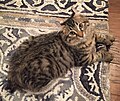Highlander cat
| Highlander | |
|---|---|
 | |
| Other names | Highlander Shorthair |
| Breed standards | |
| TICA | standard |
| Notes | |
TICA status is Advanced New Breed as of 2015, not yet eligible for championship competition. | |
| Domestic cat (Felis catus) | |
The Highlander (also known as the Highlander Shorthair, and originally as the Highland Lynx) is a new breed of cat. The unique appearance of the Highlander comes from the deliberate cross between the Desert Lynx and the Jungle Curl breeds, also recently developed. Although both of these cats claim wild species bloodlines, both have been found to be completely domestic cats.
Description
The Highlander originated as a crossbreed of the experimental Desert Lynx breed and the Jungle Curl, to add the latter's curled ears to the former.[1][2][3] They are bobtailed or short-tailed, have spotted or classic bullseye markings, mackerel and resemble the bobcat.[1][4] The Highlander has a long sloping forehead and blunt muzzle with a very wide nose.[4] The eyes are wide-set and the ears are upright with a slight curl and a slight turn in the backward direction.[4] Some have polydactyl paws but this is not a desired trait in the cats and have been proved to cause health problems in the knees and hips as the cats age. Highlanders have no known health problems, and are fond of water.[2][3] The body is substantial and very muscular.[3][4] Females can grow to between 10 and 14 pounds (4.5 and 6.4 kg), and the males between 15 and 20 pounds (6.8 and 9.1 kg).[2][3] Despite the "big-cat look", the Highlander is a human-oriented, friendly and playful cat, and very active and confident.[2] The Highlander displays tabby/lynx point or solid point coloration in various colors. Bicolored cats are not allowed in the breed standard. Although some cats are polydactyl, it is not part of the standard and it is a disqualification in the show ring.[5]
History
The Highlander breed refinement began in 2004, to distinguish the breed better from its foundation stock, and to seek competition status in major breed registries.[4] The name Highlander was adopted in late 2005.[3][4] Starting May 1, 2008, the breed was recognized by The International Cat Association (TICA) for competition in the Preliminary New Breed class,[4] and in 2016 was moved up to Advanced New Breed.[6] TICA divides Highlanders into two varieties, under the names Highlander Shorthair (HGS) and simply Highlander (HG) for the longer-haired variation.[4][7]
-
Closeup of Highlander face, with curled ears and distinctive facial features.
-
Tabby markings and bobtail.
-
Male Highlander cat.
-
Male Highlander cat, with polydactyl paws.
-
Eyes and long whiskers.
-
Closeup of a polydactyl paw, which occurs in some Highlander cats.
-
Highlander kitten.
-
Highlander juvenile, 4 months old, with polydactyl paws.
References
- ^ a b "Highland Lynx". Rare and Exotic Feline Registry. 2016 [2004]. Retrieved August 15, 2016.
- ^ a b c d "Highlander". Cats 101. Season 4. Animal Planet. Retrieved August 16, 2016.
- ^ a b c d e "Highlander". PetGuide.com. Retrieved August 16, 2016.
- ^ a b c d e f g h "Highlander Shorthair". TICA.org. The International Cat Association. August 13, 2018. Retrieved January 6, 2020.
- ^ "Highlander Cat Stats". Catster. Archived from the original on August 22, 2016. Retrieved August 16, 2016 – via Catchannel.com.
- ^ "Browse All Breeds: Advanced New Breeds". TICA.org. The International Cat Association. August 13, 2018. Retrieved January 6, 2020.
- ^ "Highlander Breed Group (HG/HGS) Standard" (PDF). TICA.org. The International Cat Association. May 1, 2015 [2014]. Archived from the original (PDF) on June 19, 2018. Retrieved January 6, 2020.








